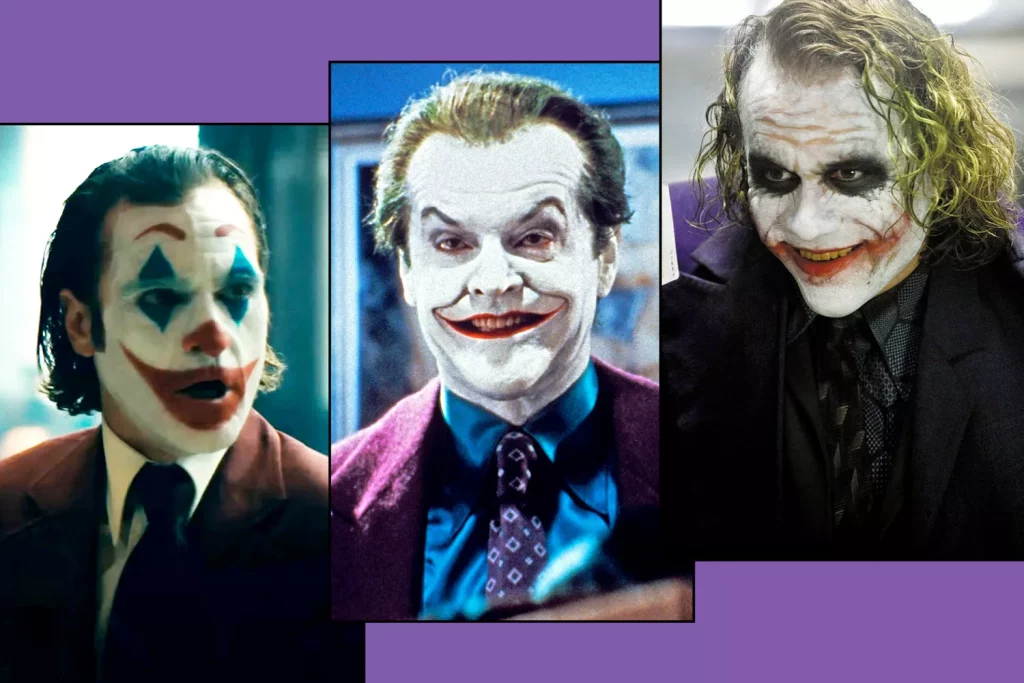Movies
The Many Faces of Chaos: Every Actor Who Brought the Joker to Life on Screen
The Joker, one of the most iconic villains in comic book history, has been a staple of the Batman universe since his debut in 1940. Over the decades, this character has transcended the pages of comic books to become a cultural phenomenon, portrayed by a variety of talented actors who have each brought their unique interpretations to the role. From campy beginnings to dark and psychological depth, the portrayal of the Joker has evolved significantly, reflecting changes in society and the film industry. This article delves into the myriad portrayals of the Joker on screen, exploring the nuances each actor brought to the character and how these interpretations have shaped the legacy of one of fiction’s greatest villains.

1. The Origins: Cesar Romero and the Joker’s First Cinematic Steps
The Joker made his first foray into live-action television with the 1960s “Batman” television series, portrayed by Cesar Romero. Romero’s Joker was a far cry from the dark and twisted figure we recognize today; instead, he embodied the campy and flamboyant aesthetic of the era. Clad in vibrant suits and sporting a signature flower lapel, Romero’s Joker was more of a mischievous trickster than a homicidal maniac. His portrayal was characterized by exaggerated facial expressions and a theatrical flair, aligning perfectly with the show’s lighthearted and humorous tone.
Romero’s Joker was instrumental in establishing the character’s place in popular culture, introducing elements such as the Joker’s iconic laugh and penchant for chaos. Despite being more of a comic book villain in the traditional sense, Romero’s performance laid the groundwork for future interpretations by cementing the Joker’s role as Batman’s arch-nemesis. While some critics argue that Romero’s portrayal lacked the depth and menace seen in later versions, his contribution to the Joker’s legacy is undeniable. By bringing the character to life in a time when comic book adaptations were rare, Romero set a precedent for the Joker’s enduring presence in media.
2. A Dark Reinvention: Jack Nicholson’s Iconic Turn in “Batman” (1989)
The 1989 “Batman” film, directed by Tim Burton, marked a significant shift in the portrayal of the Joker with Jack Nicholson taking on the role. Nicholson’s Joker was a blend of charisma, menace, and madness, diverging sharply from Romero’s flamboyant depiction. This version of the Joker was deeply intertwined with the character of Bruce Wayne, exploring themes of duality and the fine line between sanity and insanity.
Nicholson’s portrayal was multifaceted, showcasing the Joker’s psychopathic tendencies while also highlighting his charm and wit. The character’s backstory as a failed comedian who turns to crime after a series of personal tragedies added layers of complexity, making the Joker a more sympathetic yet still dangerous antagonist. Nicholson’s performance was lauded for its depth and nuance, earning him critical acclaim and solidifying the Joker’s position as a formidable villain in cinema.
The aesthetic of Nicholson’s Joker was equally impactful, with his makeup and costume design contributing to the character’s menacing presence. The exaggerated facial features, green hair, and purple suit became iconic elements that have influenced subsequent portrayals. Nicholson’s Joker balanced humor with horror, delivering memorable lines and unsettling moments that resonated with audiences. This portrayal not only revitalized the character for a new generation but also set a high standard for future actors stepping into the role.
3. Heath Ledger’s Haunting Interpretation in “The Dark Knight” (2008)
Perhaps the most critically acclaimed portrayal of the Joker came from Heath Ledger in Christopher Nolan’s “The Dark Knight.” Ledger’s Joker was a radical departure from previous incarnations, embodying pure chaos and anarchy without a discernible backstory or clear motivations. This enigmatic approach emphasized the Joker’s role as a force of nature, challenging Batman and societal norms in unpredictable ways.
Ledger’s performance was a masterclass in acting, characterized by intense dedication and a profound understanding of the character’s psyche. His Joker was both terrifying and mesmerizing, with a disheveled appearance and a sinister smile that conveyed a deep sense of unease. Ledger’s use of unconventional makeup, including smeared lipstick and scars, enhanced the Joker’s unsettling presence, making him one of the most memorable villains in cinematic history.
The Joker’s interactions with other characters in “The Dark Knight” were pivotal in showcasing Ledger’s ability to convey the character’s unpredictability and moral ambiguity. Scenes such as the interrogation sequence highlighted the Joker’s intellectual prowess and manipulative nature, while his chaotic schemes demonstrated a complete disregard for human life and societal structures. Ledger’s portrayal earned him a posthumous Academy Award for Best Supporting Actor, underscoring the profound impact of his interpretation on both audiences and critics alike.
4. Jared Leto’s Modern Adaptation in “Suicide Squad” (2016)
In the expanding universe of DC films, Jared Leto took on the role of the Joker in the 2016 film “Suicide Squad.” Leto’s interpretation aimed to modernize the character, infusing elements of contemporary culture and a more grounded, gritty aesthetic. This version of the Joker was portrayed as a flamboyant, drug-addicted gangster with a penchant for violence and manipulation.
Leto’s Joker was a departure from Ledger’s enigmatic portrayal, presenting a more overtly menacing and physically imposing figure. His appearance featured elaborate tattoos, slicked-back hair, and a more pronounced muscular build, aligning with the film’s overall edgier tone. The character’s wardrobe, dominated by stylish suits and vibrant colors, emphasized his status as a charismatic yet dangerous antagonist within the criminal underworld.
While Leto’s performance aimed to capture the chaotic essence of the Joker, it received mixed reviews from both fans and critics. Some appreciated the attempt to bring a fresh perspective to the character, while others felt that the portrayal lacked the depth and psychological complexity seen in previous iterations. Despite the mixed reception, Leto’s Joker contributed to the broader tapestry of the character’s cinematic legacy, demonstrating the versatility and enduring appeal of the Joker across different narratives and artistic visions.
5. Joaquin Phoenix’s Transformative Role in “Joker” (2019)
Joaquin Phoenix’s portrayal of the Joker in the 2019 film “Joker,” directed by Todd Phillips, offered a deeply personal and psychologically driven take on the character. Unlike previous adaptations, this film served as an origin story, exploring the societal and personal factors that could lead to the creation of the Joker. Phoenix’s performance was a raw and immersive exploration of mental illness, societal neglect, and personal tragedy.
Phoenix’s Joker was depicted as Arthur Fleck, a struggling comedian grappling with mental health issues and a lack of support from a society indifferent to his plight. This grounded approach humanized the character, presenting the Joker not just as a villain but as a product of his environment and experiences. Phoenix’s nuanced portrayal captured the descent into madness with haunting realism, evoking empathy while simultaneously showcasing the character’s capacity for violence and chaos.
The film’s aesthetic complemented Phoenix’s performance, with a gritty, realistic setting that contrasted with the more fantastical elements of previous Joker portrayals. The use of subdued colors, natural lighting, and intimate camera work enhanced the sense of immersion, allowing audiences to connect deeply with Arthur Fleck’s transformation into the Joker. Phoenix’s dedication to the role, including significant physical and emotional preparation, resulted in a performance that earned him widespread acclaim, including an Academy Award for Best Actor.
“Joker” sparked conversations about mental health, societal responsibility, and the nature of villainy, positioning the character in a new light within the Batman mythos. Phoenix’s interpretation was both a reinvention and an homage to the character’s complex legacy, offering a fresh perspective that resonated with contemporary audiences and further solidifying the Joker’s status as a multifaceted and enduring figure in popular culture.
Conclusion: The Ever-Evolving Legacy of the Joker
The portrayal of the Joker on screen has undergone significant transformation since his inception, reflecting broader changes in societal attitudes, cinematic trends, and storytelling techniques. From Cesar Romero’s campy trickster to Joaquin Phoenix’s psychologically complex antihero, each actor has left an indelible mark on the character’s legacy. These diverse interpretations highlight the Joker’s versatility as a villain, capable of embodying a wide spectrum of emotions and themes, from humor and chaos to tragedy and existential despair.
The evolution of the Joker’s portrayal underscores the character’s enduring relevance and adaptability, allowing each generation to find new meanings and connections within his persona. Whether serving as a symbol of anarchy, a mirror to societal flaws, or a study in the fragility of the human psyche, the Joker continues to captivate audiences and challenge the heroes he opposes. As the Batman universe continues to expand and explore new narratives, the Joker remains a central figure, embodying the complex interplay between heroism and villainy, order and chaos.
In essence, the myriad portrayals of the Joker reflect not only the talents of the actors who have brought him to life but also the evolving nature of storytelling and character development in modern media. Each interpretation adds depth and dimension to the character, ensuring that the Joker remains a compelling and thought-provoking figure in the annals of cinematic history. As audiences anticipate future portrayals, the legacy of the Joker stands as a testament to the power of a well-crafted antagonist to transcend the pages of comic books and become a lasting symbol in the cultural imagination.
From: Doublejoydesigns
